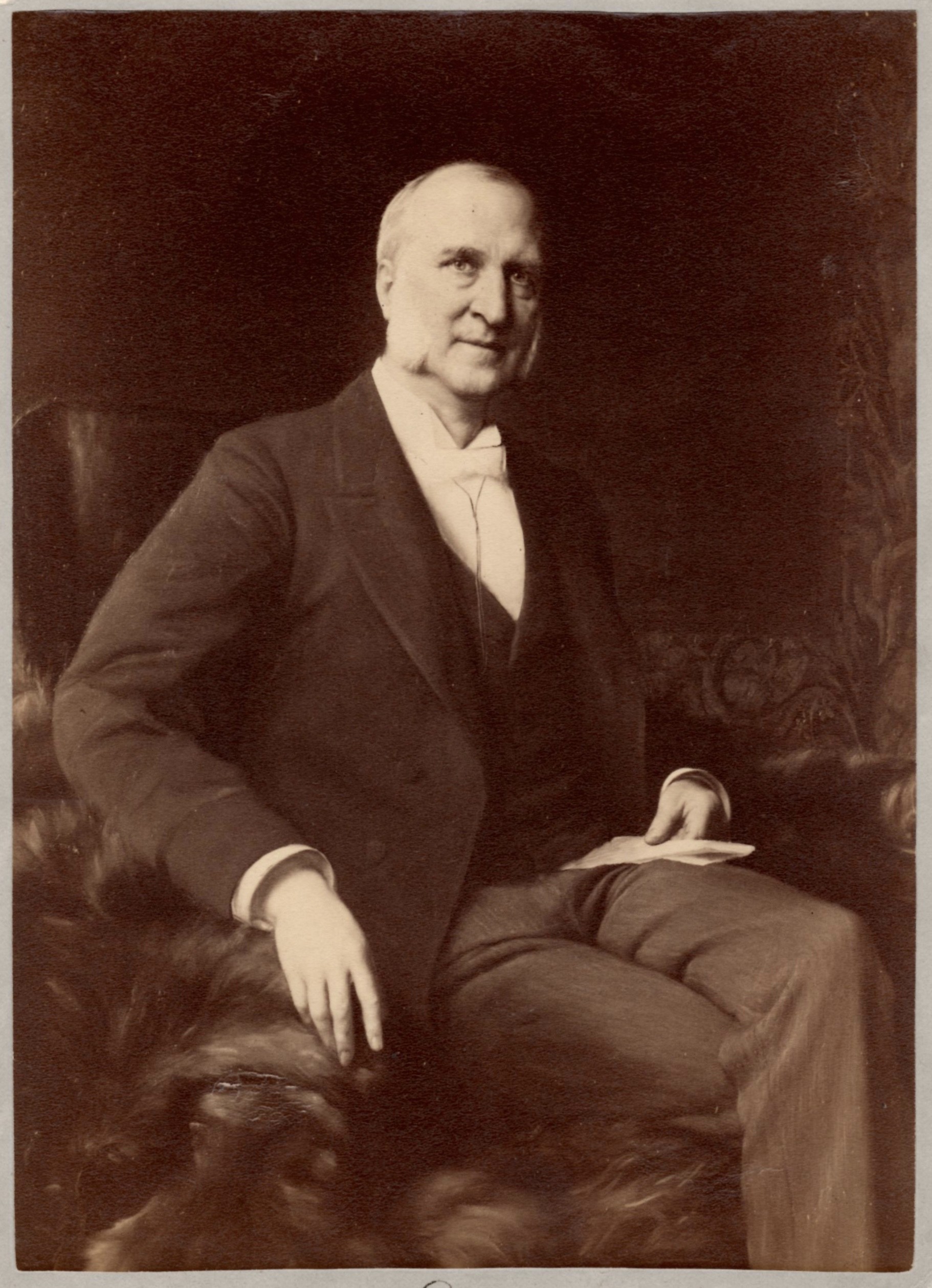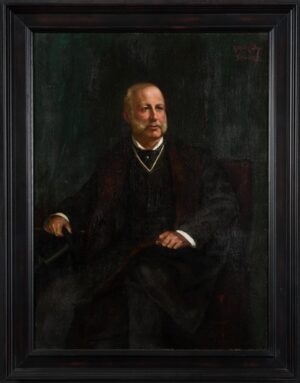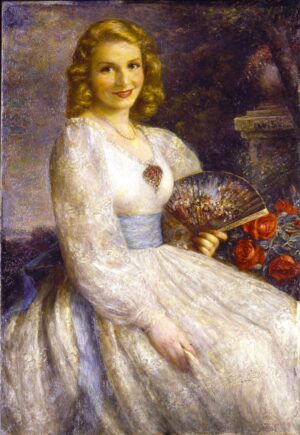DEPEW, Senator Chauncey M. (1890)
Description:
The Collector, March 1, 1891 described the picture as follows:
‘The artist shows us Mr. Depew seated, at three-quarters-length, in a green plush-covered armchair, which has a black bear robe thrown over its cushions to enhance their luxurious elasticity for his distinguished sitter. Mr. Depew sits, with his left leg crossed over his right knee, in the centre of the canvas. His attitude is easy and elegant. His left hand, resting on his thigh, holds a letter open. His right hand, from the arm of the chair on which his elbow rests, seems about to make an inquiring movement…The nervous expression of this fine but strong hand is very subtly rendered. His face which is seen in three-quarter view, is slightly upturned. The expression is that of a man listening. The face itself is admirably accurate in its portraiture, and while a lurking smile shows in the mouth the good-humored cynic we know so well, the serious and questioning eyes lend it a higher dignity and deeper meaning, in which the character of the original reveals itself. Mr. Depew is in business attire. He wears a coat and waistcoat of black cloth, and trousers of dark material, and in the rendition of these textures as of those of the other accessories the artist shows great dexterity, and sound technical skill. The drawing is admirable throughout, and the flesh painting animated in color, and firm and solid in modeling.’
Oil on canvas, 149cm x 119.7cm (58 11/16” x 47 1/8”, signed and dated 1890.
Location:
The Yale Club of New York City.
Exhibitions:
PARIS SALON, 1890, at Galerie des Artistes-Modernes, rue de la Paix, 5 – No. 1762 (listed as ‘Portrait de M. Chauncey M. Depero’)
M. KNOEDLER & CO, 170, Fifth Avenue, New York, February 1891 [along with works by François Flameng, Jan Monchablon, Jean Beraud and others].
A portrait of Depew was exhibited at the Artist’s Studio at 58, West 57th Street, New York on January 12 & 13, 1892.
THE DURAND-RUEL GALLERIES, 389, Fifth Avenue, New York, March 1 – 15, 1897
Bibliography:
Neue Zürcher Zeitung, Switzerland, September 7, 1890.
The Collector, New York, January 1, 1891.
New York Tribune, January 2, 1891.
New York World, February 14, 1891.
Evening Post, New York, February 18, 1891.
New York World, February 22, 1891
The Collector, New York, March 1, 1891.
Boston Traveller, March 7, 1891.
The Collector, New York, March 15, 1891.
New York Epoch, March 27, 1891.
Once a Week, New York, April 7, 1891.
The Press, New York, Sunday, August 9, 1891.
The Tribune, New York, Sunday, August 16, 1891.
New York Commercial Advertiser, September 5t, 1891.
Harpers Bazaar, New York, September 12, 1891.
The Mail and Express, New York, Thursday evening, January 14, 1892. (Line illustration)
Evening Post, New York, January 16, 1892.
Baltimore American and Commercial Advertiser, Friday, January 22, 1892.
Brooklyn Times, January 27, 1892. (Satire on Chauncey M. Depew)
La Revue, Lausanne, Switzerland, Tuesday, February 9, 1892.
The Epoch, New York, February 12, 1892.
The Social Truth, Saturday, April 23, 1892.
The American University Magazine, May 1895, Vol. II, No. 1 (reproduced)
New York Times, March 2, 1897
Sunday World, New York, May 2, 1897 (reproduced)
The New York Times Supplement, Sunday, May 2, 1897
Lois Marie Fink, American Art at the Nineteenth Century Paris Salons, (Cambridge, England, 1990), p.374
A portrait of Depew was exhibited at THE NATIONAL ACADEMY OF DESIGN, New York, in the ‘Loan Exhibition of Portraits’ of October 31 – December 7, 1895. It’s bibliography is as follows:
New York Morning Advertiser, October 26, 1895
New York Tribune, October 27, 1895
New York Sun, October 30, 1895
New York Recorder, October 30, 1895
New York Tribune, October 30, 1895
New York Morning Advertiser, October 31, 1895
Town Topics, October 31, 1895
Vanity, New York, November 2, 1895
The sitter was a United States Senator, President and Board Chairman of the New York Central Railroad, and notable Public Speaker. Son of Isaac Depew (d. 1869), shipowner and merchant, and Martha Mitchell Depew (d. 1872). Graduated Yale University in 1856, he was admitted to the bar in 1858. Served in the New York state legislature and elected New York’s secretary of state in 1863. Depew joined the New York Central Railroad in 1866 at the invitation of ‘Commodore’ Cornelius Vanderbilt (1794-1877), advancing to the presidency in 1885. In 1899, at the age of sixty-five, he embarked on a twelve-year tenure in the United States Senate, but, until the end of his life, remained Chairman of the Board of the New York Central. In 1871 Depew married Elsie A. Hegeman (died 1893), with whom he had one son, Chauncey M. Depew, Jr. (1872-1931). He married secondly May Palmer (d. 1940) in 1901; they had no children. A leading business and political figure Depew was considered the most distinguished public speaker in America; in 1886 he delivered the principal address at the dedication of the Statue of Liberty; six years later he was chosen to speak at the laying of the cornerstone of Grant’s Tomb; and, in 1892 he presented the dedicatory oration at the Chicago World’s Fair. At the age of ninety-one, in 1925, his annual birthday speech was broadcast on the radio. He was known of “the most recognized living American, with the exception of the President of the United States.” Depew died in St. Augustine, Florida, aged 94 on April 5, 1928 of bronchial pneumonia. He had signed his will on January 26, 1928, prior to his departure.
Bibliography of sitter:
William A. Eardley, Chronology and Ancestry of Chauncey M. Depew with Fifty-four affiliated families of New York, New Jersey and New England, Privately Printed, New York, 1918
Chauncey M. Depew, My Memories of Eighty Years, New York, 1924.
—
The description above was written by the Editor and Proprietor of The Collector, Alfred Trumble, who in fact informed the artist on February 20, 1891, that this article was to appear (artist’s papers):
‘My dear Mr. Ury,
There will be an article on your Depew and yourself in the next paper. I trust it may please you.
You have made a fine portrait of Mr. Depew – strong in character, ripe in color & admirable in execution. It should do you a great deal of good.
I do not think Mr. Depew will ever regret his sittings. I know no-one who could have made him live as you have, excepting, possibly, Mr. Eastman Johnson, & I do not think he could have caught his spirit so well.
You have the fire of youth that Mr. Johnson has outlived. Paint another portrait or two like this & you will have your villa at Munich ten years hence, when I may have the pleasure of calling on you, for a dejeuner à la fourchette under the garden arbor some fine morning.
A la bonne heure, Alf. Trumble.’
—
Further Notes:
The review of the DURAND-RUEL show in 1897 in the New York Times, March 2, 1897 says this portrait ‘was executed some years ago.’ The New York Times Supplement, Sunday, May 2, 1897, in a description of Depew’s house at 43, West Fifty-fourth Street, New York, says that ‘On the walls of the parlor, directly opposite each other, are two large paintings of Dr. Depew and the late Mrs. [Elise Hegeman] Depew. Both are the work of Müller Ury. Dr. Depew’s nieces, who live with him, are unanimous in declaring that the Ury portrait of their uncle is the best likeness of him ever made.’ (p. 18) This suggests that Depew owned the 1890 portrait of himself and there is a letter (artist’s papers) from Depew written from his home at 43, West 54th Street, New York, dated January 28, 1896 which says:
‘Dear Mr. Muller-Ury,
You have painted for me life size portraits of Mrs. Depew and of myself. I write to tell you how thoroughly I am satisfied with them both as likenesses and from an artistic point of view.
Very truly yours, Chauncey M. Depew.’
Depew may have written this letter for the artist to show people, but it proves that a pair of Muller-Ury portraits of Depew and his late wife were in his possession.
A portrait of Depew was exhibited at THE NATIONAL ACADEMY OF DESIGN, New York, in the ‘Loan Exhibition of Portraits’ of October 31 – December 7, 1895 and it seems reasonable to suppose that it was again the 1890 portrait lent by Depew himself.
—
I am grateful to Michael O’Hanlon, the Yale Club Manager, for helping me trace this work in the Yale Club storerooms and getting it on view.



![OELRICHS, [Natalie] Lily (Later Mrs Peter Martin; Later Duchess of Mecklenburg)](https://www.muller-ury.com/wp-content/uploads/2018/11/digiScanLtd.com-Conrad69-1-300x511.jpg)

